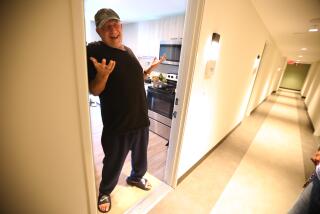N.Y. Outreach Workers Try to Help Homeless Who Call Subway Home : Street Life: In 2 years, the MTA Connections’ staff has dealt with 2,900 people on the trains, in Grand Central Terminal and Penn Station.
- Share via
NEW YORK — The old man is clean and shaven, but napkins are stuffed in his patent-leather shoes to keep them from falling off, and a paper bag full of clothing sits at his side.
Tommy McInnis tries to strike up a conversation: “Hi, wanna come out and talk? We’ll sit on the bench. Maybe we can find you something more comfortable than the train, something long-term.”
The man doesn’t want to leave his seat, so McInnis and Shari Siegel--outreach workers for the Metropolitan Transportation Authority’s Connections program for the homeless--jump on the E train and start chatting.
“I’m glad you came along,” the man tells them, and he shares childhood memories of creamy fresh milk and fat blueberries on a New Hampshire farm. He talks about his plans: He’s just been released from the hospital and is en route to stay with a friend.
McInnis and Siegel give him their phone number and then move on, seeking to persuade other homeless people to move from the subway system into housing. A few days later, the old man calls and they find him a place to stay.
The underground homeless are nothing new. Since 1982, police have transported homeless people from trains and stations to shelters 55,000 times. Previous outreach programs were limited to certain stations.
Connections is the first systemwide effort to reach the homeless, and its philosophy is different: It’s not enough to take someone to a shelter; you have to get to know them, determine their needs and motivate them to make the move themselves. “If you had to figure out the one thing that’s keeping you from housing, what would it be?” is how McInnis often starts his assessments.
Since starting two years ago, Connections’ staff of 22 has dealt with 2,900 different homeless people in the subway, Grand Central Terminal and Penn Station. Some are encountered once; others are seen again and again before they agree to accept help.
“The beautiful part of it is, they’re not just sending these people somewhere; they’re checking on them,” said Michele Butchko, director of homeless services for the MTA.
Of more than 600 homeless people identified by Connections in its first year, 221 were placed in shelters, psychiatric hospitals, nursing homes and other programs. At least 34 returned to MTA property, but the majority did not.
The MTA developed Connections, budgeted $1 million a year for it, and hired Gouverneur Hospital, a city facility, to run it and hire staff. The employees range from professionals like Siegel, a psychiatric nurse, to McInnis, a former bartender whose streetwise gregariousness makes up for his lack of degrees.
At the West Fourth Street station the two see a man asleep on a bench, a pile of tattered clothes beside him. “Hello, sir!” McInnis calls out. “How are you?” The man opens his eyes.
Within minutes McInnis learns that the man is on welfare. He gives him a phone number for an agency to help him use his benefits to obtain a room.
Nearby, a ragged man frantically searches through a garbage can.
“Hello, how ya doing?” Siegel says.
“Not too bad,” the man replies, nodding warily. “You?”
Moments later he hurries away--but this is the beginning, not the end, of their relationship. When they see him again, on some other day, the outreach workers will try again to make a connection, trying to gain his trust.
On the way to 59th Street, they pass a woman who appears agitated, mumbling as she runs up the stairs. She’s rebuffed them in the past, so they let her go.
And they run across an old friend, a one-legged man who just got out of jail.
“Hey, how are you?” McInnis says. “The station manager was telling me about you.”
“Yeah? What’d he say?”
“Said you’re still hanging around.”
They laugh and agree to meet the next day in the station to talk about finding a better place to live.
Some success stories stand out, such as the pregnant tunnel dweller who had been approached by outreach workers many times before agreeing to get treatment for a drug habit. Moments after a Connections team met her at the hospital where she was to go for detox, she went into labor.
“The baby was born in a hospital and she was born alive,” Butchko said proudly. The child is now slated for adoption.
At the other end of the life cycle, a Connections worker found a homeless acquaintance semiconscious in Grand Central and had him hospitalized. He died two days later. McInnis got a funeral home to bury him for free and is trying to find the man’s next-of-kin.
“We cover everything,” said Siegel, “from cradle to grave.”
More to Read
Sign up for Essential California
The most important California stories and recommendations in your inbox every morning.
You may occasionally receive promotional content from the Los Angeles Times.













